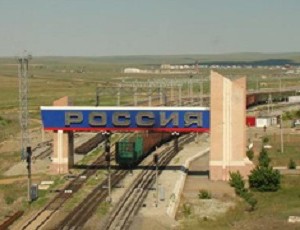Longest Railway in the World Now Connects China to Southern Europe
Earlier this month, the first freight train arrived in Madrid from the Chinese trading city of Yiwu. The route runs from Yiwu in Zhejiang province, through Xinjiang in Northwest China, Kazakhstan, Russia, Belarus, Poland, Germany and France. Previous rail routes already connected China to Germany; this railway now included Spain and France as well.
The railway cuts transport time between the two cities in half. To send a container of goods from Yiwu to Madrid, you previously had to first send them to Ningbo for shipping. The goods would then arrive in the port of Valencia, to be taken either by train or road to Madrid. This would cost roughly 35 to 40 days, whereas the new freight train only takes 21 days. The new route is cheaper than air, and faster than sea transport.
An added benefit is that the railroad stops in 7 different countries, allowing these areas to be serviced as well. The rail route is also safer than shipping, as a ship has to go past the Horn of Africa and the Malacca Straits, which are dangerous areas.
Yiwu-Madrid link the seventh railroad connecting China to Europe
The Yiwu-Madrid freight route is the seventh rail road connecting China to Europe. The first one is the Chongqing – Duisberg, which opened in 2011 and connects Chongqing, one of the major cities in Central China, to Duisberg in Germany. This was followed by routes connecting Wuhan to the Czech Republic (Pardubice), Chengdo to Poland (Lodz), Zhengzhou – Germany (Hamburg), Suzhou – Poland (Warsaw) and Hefei-Germany. Most of these routes go through Xinjiang province and Kazakhstan.
![]() RELATED: The Chongqing-Xinjiang-Europe International Railway
RELATED: The Chongqing-Xinjiang-Europe International Railway
Currently, the China-Europe railroads are still subsidized by local government, but as imports from Europe to China start to fill trains going eastward, the route is expected to start making profit. For the moment, the rail link is mainly being used for Chinese exports to Europe. Western producers of pharmaceuticals, chemicals and foods were especially interested in using the railroad for exports to China.
Yiwu the first third-tier city to have rail link to Europe
With just over a million inhabitants, Yiwu is by far the smallest city with a direct rail link to Europe. It is however not hard to see why policy makers decided on Yiwu as the next city in the ‘New Silk Road’ of railways linking China to Europe. Located in central Zhejiang, Yiwu has the largest wholesale market of small goods in the world, according to a report jointly issued by the UN, the World Bank and Morgan Stanley. The Yiwu International Trade Market spans an area of four million square meters. It is also the wealthiest county-level city in China, according to Forbes. The city is one of the major sourcing centers for products ranging from toys and textiles to electronics and spare car parts. According to Xinhua, 60 percent of all Christmas trinkets are from Yiwu.
The city is especially popular with Middle Eastern traders, who flocked to the Chinese city after the events of 9/11 made it hard for them to do business in the US. Even today, Yiwu is home to the largest Arab community in China. In fact, the city is mainly visited by traders from the emerging markets. However, with China’s currency rising and its economy shifting away from exporting small manufactured goods, Yiwu will need to diversify as well. The new railroad to Madrid may be a major step in that direction.
If you would like to learn more about investing in Yiwu, or what benefits the new rail link may have to your business, please contact us at china@dezshira.com.
|
Asia Briefing Ltd. is a subsidiary of Dezan Shira & Associates. Dezan Shira is a specialist foreign direct investment practice, providing corporate establishment, business advisory, tax advisory and compliance, accounting, payroll, due diligence and financial review services to multinationals investing in China, Hong Kong, India, Vietnam, Singapore and the rest of ASEAN. For further information, please email china@dezshira.com or visit www.dezshira.com. Stay up to date with the latest business and investment trends in Asia by subscribing to our complimentary update service featuring news, commentary and regulatory insight. |
![]()
 Sourcing From China
Sourcing From China
In this issue of China Briefing Magazine, we outline the various sourcing models available for foreign investors and discuss how to decide which structure best suits the sourcing needs of your business. Perhaps the most important factors to consider when choosing a sourcing structure are your staffing requirements, your need for operational flexibility, and which option offers the greatest cost efficiencies. We compare how each of these factors match up with the available sourcing platforms in order to help foreign businesses find the best option for their specific sourcing needs.
 Adapting Your China WFOE to Service China’s Consumers
Adapting Your China WFOE to Service China’s Consumers
In this issue of China Briefing Magazine, we look at the challenges posed to manufacturers amidst China’s rising labor costs and stricter environmental regulations. Manufacturing WFOEs in China should adapt by expanding their business scope to include distribution and determine suitable supply chain solutions. In this regard, we will take a look at the opportunities in China’s domestic consumer market and forecast the sectors that are set to boom in the coming years.
 Selling to China
Selling to China
In this issue of China Briefing Magazine, we demystify some complexities of conducting business in China by introducing the main certification requirements for importing goods into the country; the basics of setting up a representative office; as well as the structure and culture of State-owned enterprise in China. Finally, we also summarize some of the export incentives available in several key Western countries.
- Previous Article Investing in China’s Art Auction Market
- Next Article China-Russia Trade to Boom in 2015

 By
By 







